“If Japanese banks continue
to fund coal power in Indonesia,
it means Japan colonized us
for the second time!”
Dian Paramita
“To the investors and banks in Japan, I am asking with all due respect: please end your funding and support for the two coal plants in our village. The first power plant has already destroyed our lives and our future. Why would you support the second one if you know it will make our lives even worse?” asked Domo, a local painter and sculptor, from Mekarsari Village, Indramayu, West Java, Indonesia.
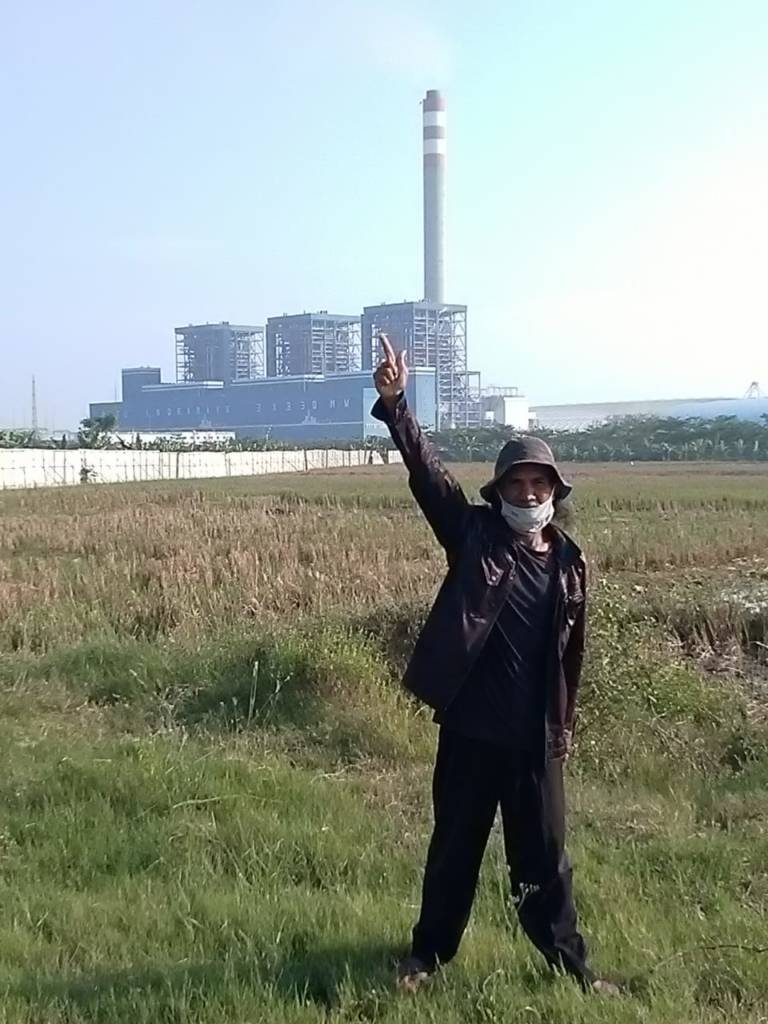
Domo in front of the First Coal Power Plant Indramayu in Mekarsari Village (June 2020).
Photo credits: JatAyu
In 2010 the Indonesian government constructed the Pembangkit Listrik Tenaga Uap (PLTU), a coal-fired power station that consisted of 3 units that produce a generating capacity of 990-megawatt (MW), in Mekarsari Village, initially through a US$562 million loan from the China Development Bank.
This year marks the decade of its operation and the 10 years of suffering that it has brought to the local residents, who in spite of the impacts of the power plant have never ceased in raising their voices of concern over the facility’s impacts to their community.
Since the operation of its first unit, the coal plant has caused damage to the local ecosystem which adversely affected the community’s livelihood.
This forced them to act through organizing a movement that demanded government action to stop the operation of the first unit and the cancellation of the second one. In 2015 the network became known as JatAyu (Jaringan Tanpa Asap Batu Bara Indramayu, Indramayu Free Coal Smoke Network).
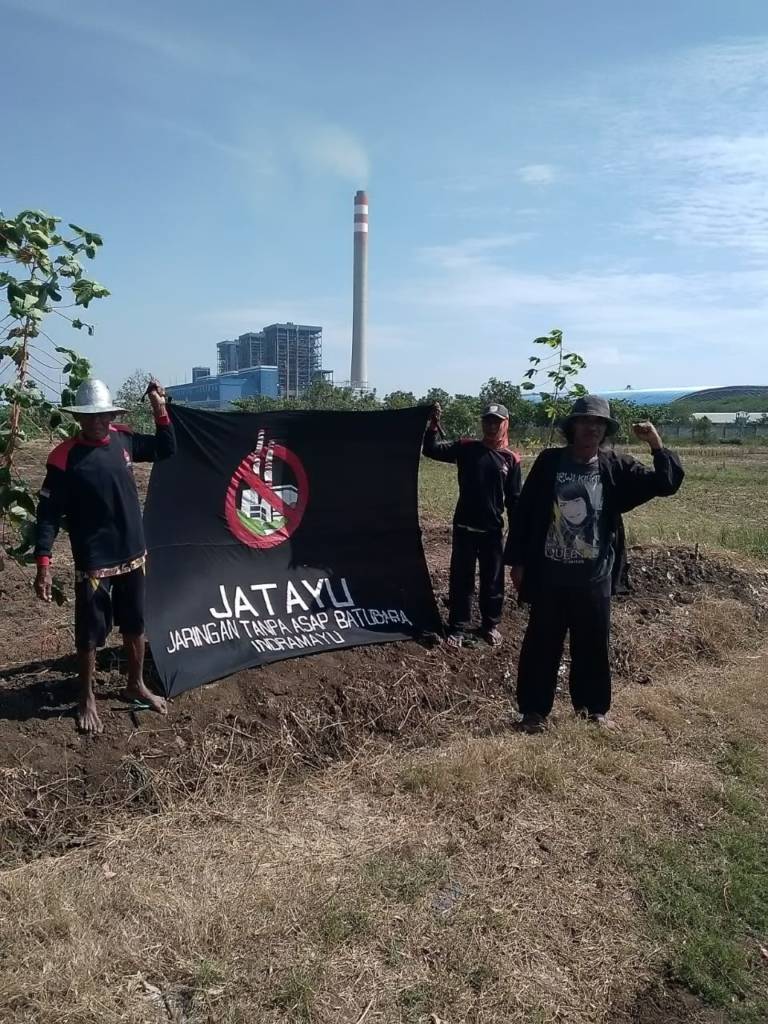
JatAyu activists in front of the First Coal Power Plant Indramayu in Mekarsari Village.
Photo credits: JatAyu
According to Domo, who is also a part of JatAyu, the first coal power unit has not only polluted their environment, it has also caused tensions within the social fabric of the community as well as usher in human rights violations.
“The damaged caused by the first coal power station can be classified into 3Ds: First damage to the environment, second is damage to the local economy and well-being of the community, and third is the damage it brought to morals and social life, in the village,” said Domo.
“The first D is damage to the environment,” Domo mentioned. The natural environment that was once so prosperous has now become dry and barren. Immediately after the first unit started operating, the coconut trees started dying one by one. Now 10 years on, none of the trees has survived.
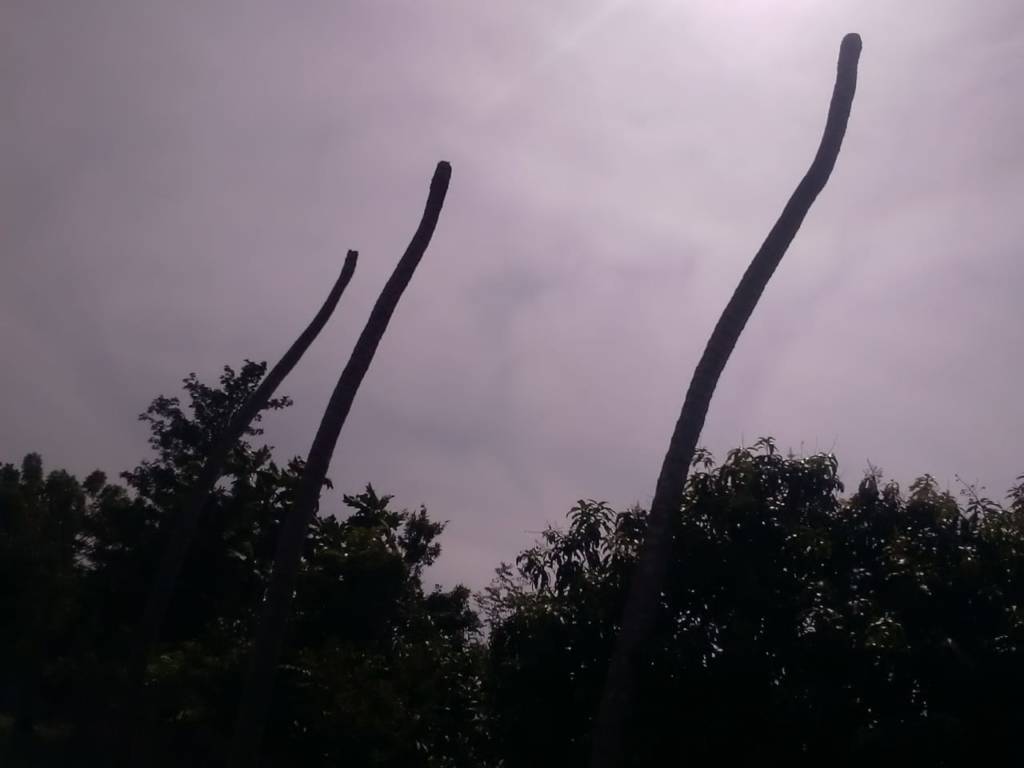
Coconut trees in Mekarsari Village, Indramayu died without producing coconut and leaves (June 2020).
Photo credits: JatAyu
“Sometimes it grows for a while, but the trees could no longer produce coconuts or even leaves. Then after a while, they just die,” said Tarmudi, one of JatAyu coordinators in Mekarsari Village.
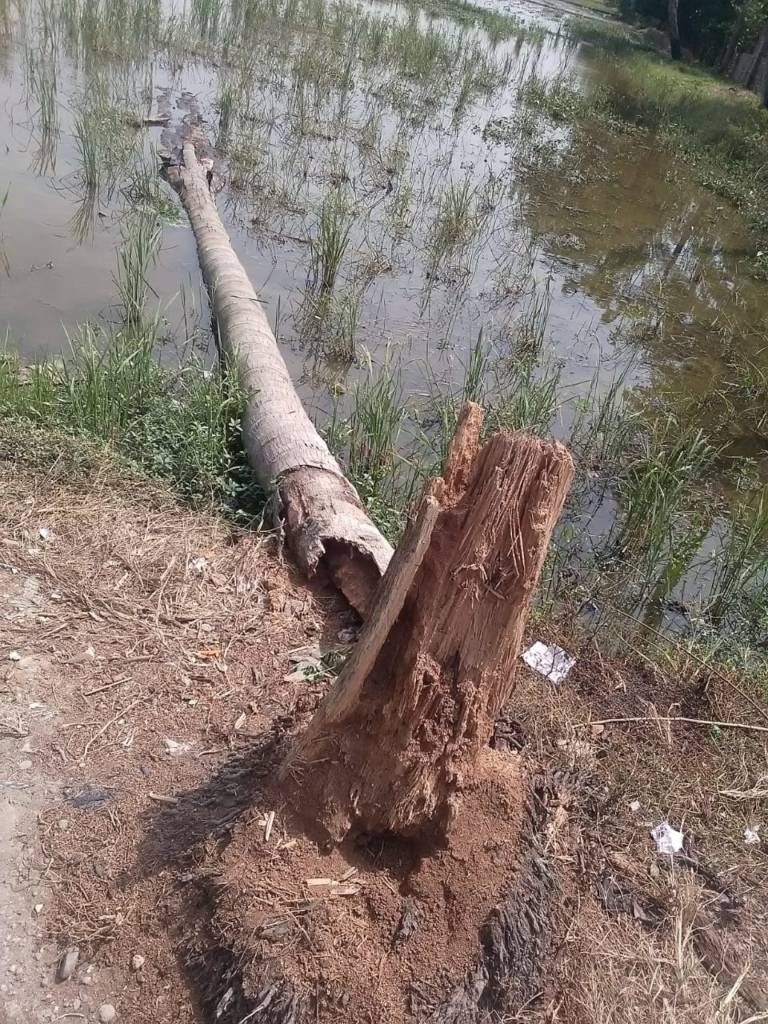
A coconut tree in Mekarsari Village Indramayu died and fell to the ground (June 2020).
Photo credits: JatAyu
“Visitors often came to our village to find good quality coconuts. Now, not even one single coconut tree can survive here!” exclaimed Domo, as the other farmers who were sitting with him nodded.
Furthermore, Domo highlighted that the farmers and fishermen are also complaining because it has now become more difficult for them to grow crops and catch shrimp because of the contamination caused by the pollutants from the coal plant.
“The second D is Damaging the Economy and Well-being,“ said Domo. Before 2010, it was normal for farmers to harvest up to 6 tons of rice in a span of a hundred days using only a hectare of land. In fact, at that time a hectare can also produce up to 15 tons of vegetables like onions and eggplants in a hundred days. “Before the first coal plant started operating in his village, our rice, onions, and eggplants were high-quality!” said Sukma, a local landless farmer.
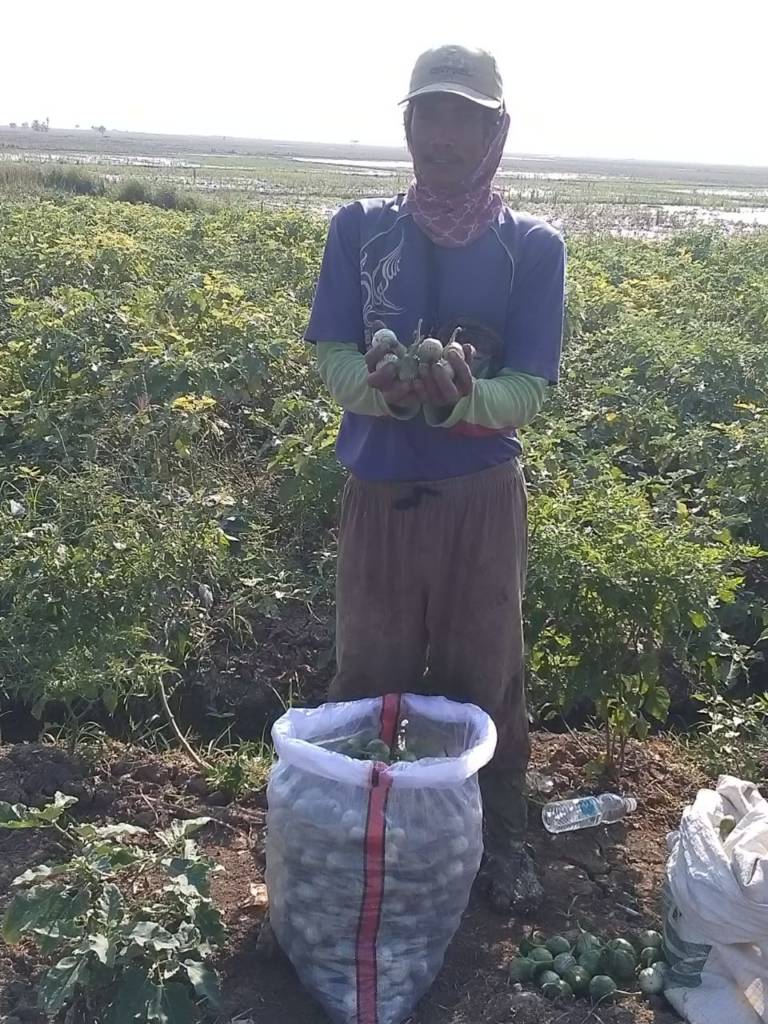
Sukma and his high-quality eggplants, before the first coal-power plant, existed in Indramayu in 2010.
Photo credits: JatAyu
“But today, if we can harvest 2 tons of rice from a hectare rice field in 100 days, we are already grateful,” said Domo.
Meanwhile, harvesting onion is worse than rice. This year, one of the onion farmers, Darisem, failed to harvest her onions. It is a huge loss for her. “Planting onions is the most difficult one in our village,” said the head of JatAyu, Rodi. He is also a landless farmer who also faces the direct consequences of the first coal power plant in Mekarsari.

Darisem showed her onion failed to harvest in Mekarsari, Indramayu, in June 2020.
Photo credits: JatAyu
Now, most of the farmers decided to stop planting onions. They rather plant rice or eggplants. Although they are aware that the quality of their rice and eggplants are obviously not as good as it was a decade ago.
Also as mentioned before, the fishermen in Mekarsari Village are facing direct consequences from the first coal power plant as well. Since the 1420s, Indramayu has been known as one of the regions in Indonesia which produces the best terasi (shrimp paste sauce) made from rebon shrimp in Indonesia. Mekarsari is one of the villages in Indramayu that was selling a lot of rebon shrimp for terasi to the rest of Indonesia.
“It was easy for my fisherman friends to catch rebon shrimps,” Domo said. Before 2010, they only needed 5 liters of solar to sail about 5 kilometers (km) and get more than 150 kilograms (kg) of rebon shrimp. They can feed their families and sell the rest to make a living.
Now, they have to spend 20 liters of solar to sail about 50 km, only to get less than 5 kg of rebon shrimps. The fishermen said they cannot sell anything. They can not even feed their family from what they get from the ocean.
On Wednesday, 17th June 2020, a local fisherman named Mistra said, “I have been fishing shrimp from 06.00 AM in the morning to 10.00 AM, but I got nothing.” This first coal power plant has changed the tradition of the Indramayu community that has existed since 600 years ago.
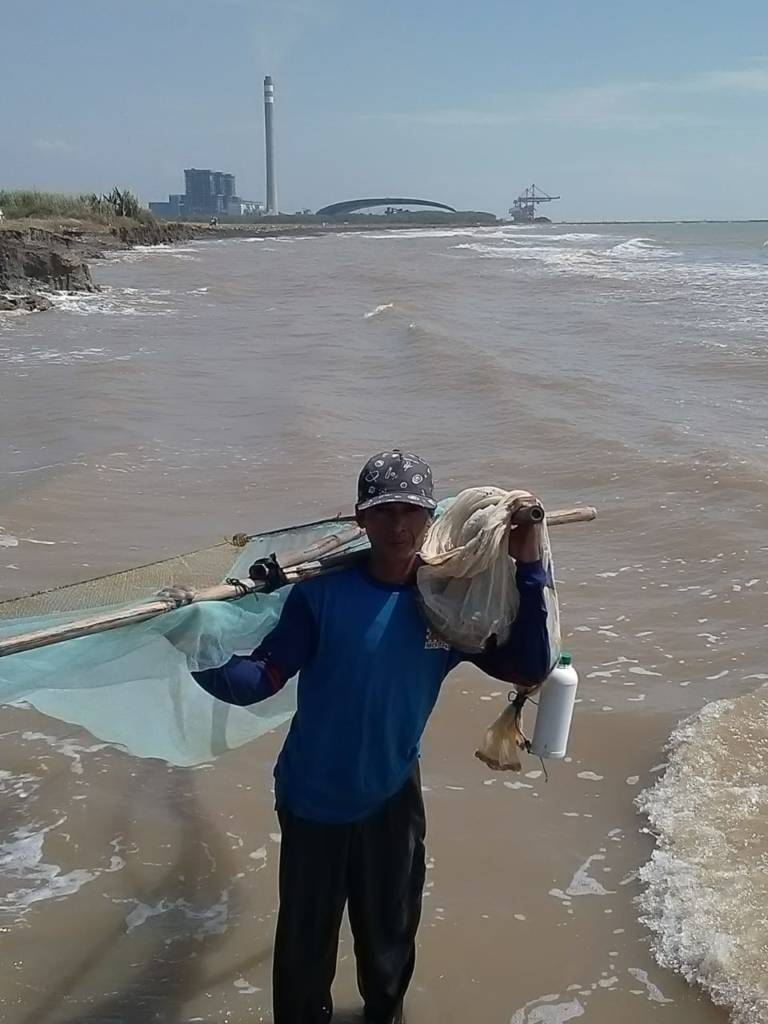
Mistra, a local fisherman in Mekarsari, Indramayu (June 2020)
Photo credits: JatAyu
The locals are not only struggling to feed themselves and their families but are also feeling hopeless about the future. They have tried to find alternative ways to make a living. However, not everyone has the skills and abilities to do so, since most of them are raised to be farmers and living as farmers were actually already enough for them.
At first, the government and the company said that this project will create jobs and give better opportunities for the locals. “But, in reality, the best job they have offered us is to serve as the security guards. Does that sound a better opportunity for the locals? How come none of the engineers in our village are working there?” Domo asked.
The local residents are also worried about the pollution from the coal ash which is considered causing respiratory disease, especially to young children stricken with Acute Respiratory Infection (ARI). This infection prevents normal breathing function and can cause death for children under 5 years old.
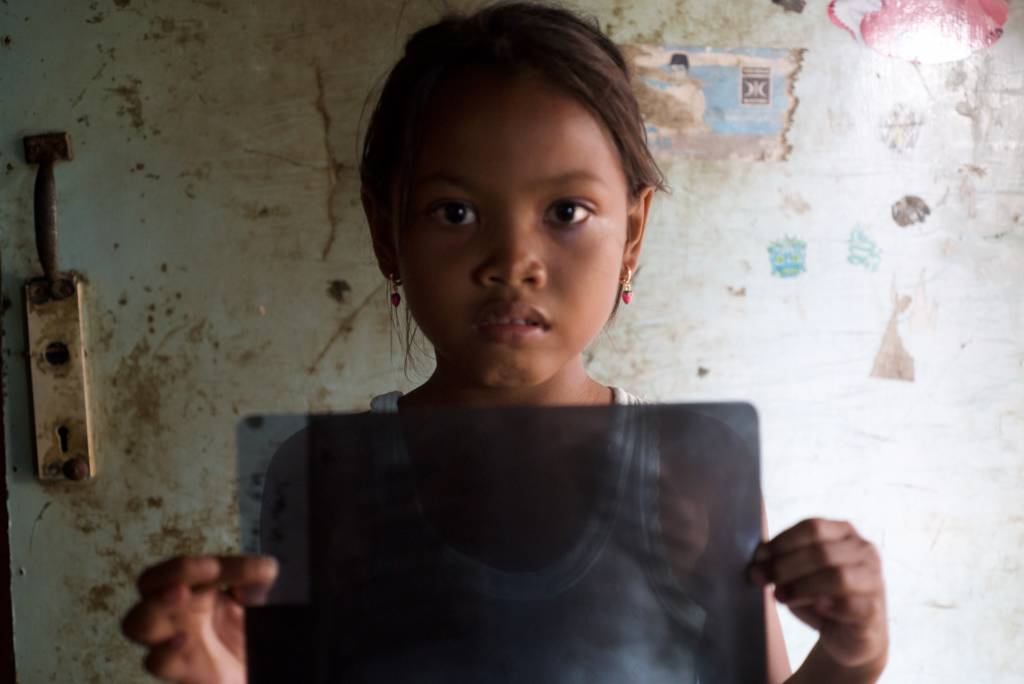
An 8-year-old girl from Indramayu shows an X-ray showing that she has lung disease (2017).
Photo credits: Ardiles Rante
Erisa, a young mother who is also living near the first coal power plant in Indramayu, lost her 6-month son named Fiki in 2013. The cause of death was lung disease. Even now she is also suffering from the same disease as her son.
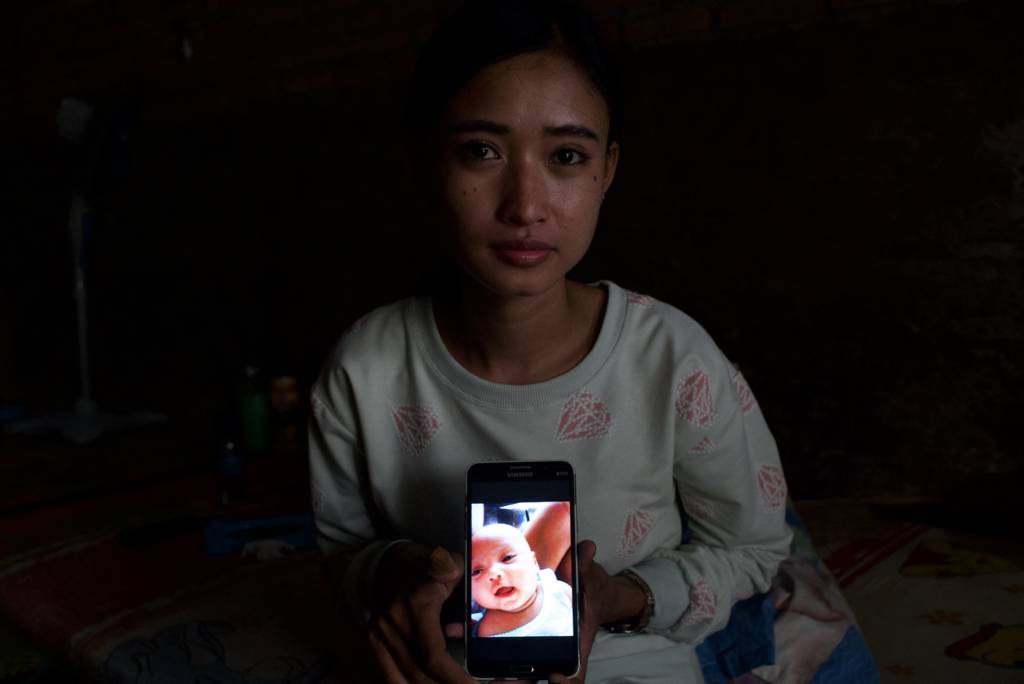
Erisa showing a picture of her son, Fiki, who passed away in 2013 due to lung disease (2017).
Photo: Ardiles Rante
“The coal ash pollution impacts our children more. You can check, most patients in the clinics in our village are children as young as five years old being treated,” said Rodi.
“If you ask me how the coal plant benefits the local residents my quick response would be zero –it provides zero benefits. We get nothing but nightmare after nightmare. Our nature is destroyed, more people are unemployed, and the pollution from the coal ash impacted our health. This is why we said this coal power plant is damaging the economy and well-being,” said Domo.
The third D is that it damages our moral and social life. “Our village was peaceful before. No disappointment, no frustrations, no hatred,” Domo claimed. However, the local government and the coal company never invited the locals, especially the landless farmers, to discuss their project plans. The locals admit they do not know anything about the coal power plant. However, now the locals feel they are the ones who are facing the consequences.
The locals, especially the JatAyu community, also face intimidation from the company. It was so bad that seven farmers who also happen to be JatAyu members ended up in prison. Sukma, the farmer who earlier shared his experience on the power plant’s impacts on his eggplants, was among them.
In 2016, the locals and activists protested in front of the first coal power plant’s building. It was there that they were beaten up by the facility’s security personnel and the police. Following that they immediately went to the hospital to get their wounds treated and checked so that they can have documented evidence of their injury when they reported it to the police. However, in the end, four farmers present in the protest who were also JatAyu members ended up being jailed for 6 months.
The next year, in 2017, three farmers were sentenced to jail for 6 months, after they were accused of flipping over the Indonesian flag which is considered as a form of insult to a national symbol.
“Where is the moral for those people? These coal power plants did nothing but damage our life, our peaceful life,” said Domo. They feel these problems have been damaging the harmony of their social life.
“And now, even as we are still struggling to overcome the damage from the power plant, the Indonesian government is planning to build a second power plant in our village,” said Domo. The report said the government received funding from the Japan International Cooperation Agency (JICA), the aid agency of the Japanese government.
After taking a deep breath, he continued, “If they are planning to support this coal power project —why don’t they just drop bombs on us now, rather than kill us slowly like in the past 10 years? We are starving and hopeless.”
It also terrifies the local residents even more, since the second coal power plant will be bigger than the first. Karyati, a mother who works as a landless farmer said, “You know we have been struggling from the first one. We are asking Japan, please do not fund and support the second one. Please stop.”
“If you do, it’s almost like Japan has colonized us again for the second time!” Domo shouted. He said he already told this to the Japanese Embassy in Jakarta.
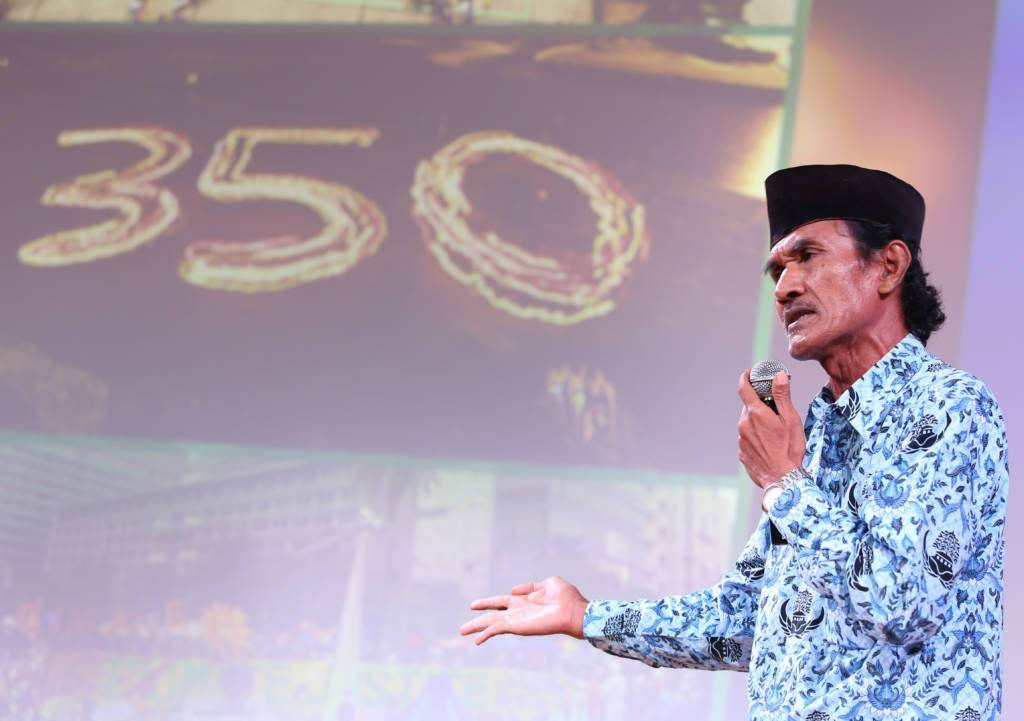
Domo sharing his story at an event for Global Divestment Day in 2018.
Photo credits: Malahayati
Domo was not an activist before. He was just a happy cheerful artist. Today he is 63 years old, still working as a painter and sculptor, a far cry from the person that he used to be.
When 350.org Indonesia asked him about things that make him happy in his life, we were expecting his answers will be something in his daily life activities, such as listening to music or laying down next to the paddy fields.
However, Domo answered, “What makes me happy… If I can live just like 10 years ago before the first Indramayu coal power plant existed. Ten years ago I was happy. We were all happy. Our life was more than enough and we felt grateful. Not like today.”
Today, Domo spares his time to actively voicing their rights. Domo said he is very proud of Mekarsari people because he never felt alone in this battle. He fights with most of the people in Mekarsari and it creates a strong bonding in their movement in JatAyu.
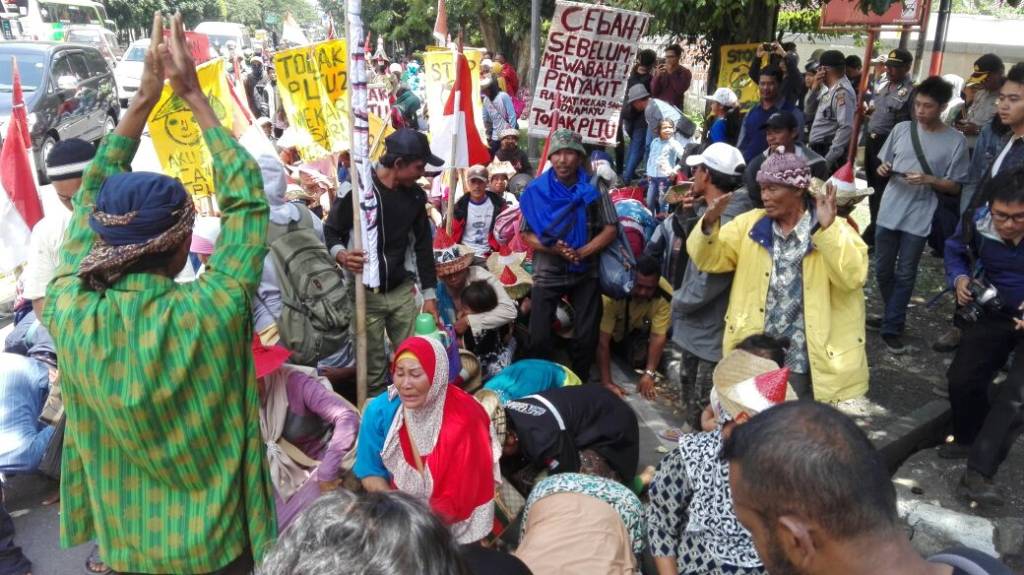
JatAyu protest against the proposed of the second Indramayu
coal power plant expansion in front of Bandung Administrative Court in 2017.
Photo credits: WALHI
“But I don’t think our movement will be this powerful if for the leadership of the head of JatAyu, Rodi, and the support from many people including big organizations,” said Domo. Rodi smiled.
Rodi explained, since 2015, they have been doing anything they could to achieve their demands. In 2017 for example, they went to the court to sue the second Indramayu coal power plant, because their Environment Impact Assessment has expired. However, JatAyu lost
In the past years, they also managed to have some meetings with the Regent of Indramayu, The Indonesia Human Rights Commission, The Japanese Embassy in Jakarta, The Secretary of State, and even went to the Presidential Palace.
Sadly, none of them did anything significant to stop the government of Indonesia on building the second coal power plant in Indramayu. Nothing has changed. The first coal power plant still exists and the second coal power plant starts building its first chimney in Sumur Adem village, close to Mekarsari Village.
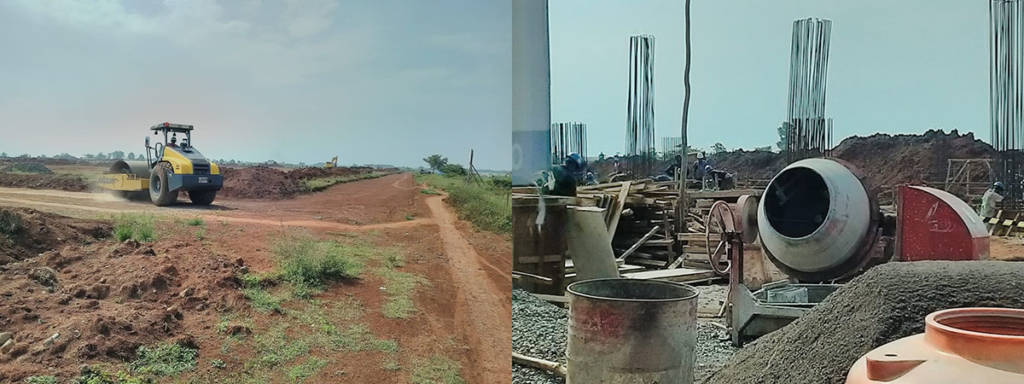
The construction activities to build the second coal power plant in June 2020.
Photo credits: JatAyu
However, people in Mekarsari Village along with JatAyu still believe that there are more good people in the world than the bad ones. Therefore, they said they still have hope. “We are hoping good people like you will always be aware of your decisions, including decisions in investing your money in a project which won’t hurt any soul,” said Domo with slight hopefulness.
